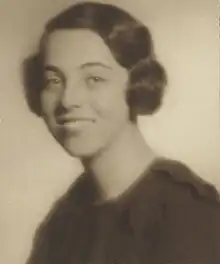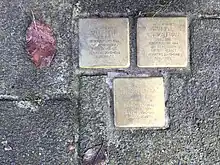Herta Mohr
Herta Theresa Mohr (Vienna, 24 April 1914 – Bergen-Belsen, 15 April 1945) was an Austrian-born Jewish Egyptologist who lived in the Netherlands. She published on the mastaba chapel of Hetepherakhty in the National Museum of Antiquities in Leiden, the Netherlands, and died a Holocaust victim.[1]
Herta Mohr | |
|---|---|
 Herta Theresa Mohr, 1937 | |
| Born | 24 April 1914 |
| Died | 15 April 1945 (aged 30) |
| Cause of death | Holocaust victim |
| Nationality | Austrian, stateless |
| Education | Realgymnasium Wien XIV |
| Alma mater | University of Vienna, Leiden University |
| Scientific career | |
| Fields | Egyptology |
| Academic advisors | Adriaan de Buck |
Life, education, and work
Herta Mohr was born in Vienna, the only child of Adolf Israel Mohr and Gabriele Kaufmann. Her father was a doctor who served in field hospitals during the First World War; he received a Golden Cross of Merit for this.[2] Mohr first enrolled as a medical student at Vienna University but switched to Oriental Studies. In 1937–1938 she followed classes on Egyptology and African languages taught by Wilhelm Czermak and Heinrich Balcz.[3] Mohr and her parents moved to Leiden; she enrolled at Leiden University in November 1937.[4]
In September 1938 she gave a lecture on the tomb chapel of Hetepherakhty, an ancient Egyptian monument dating to the Old Kingdom, at the 20th International Congress of Orientalists in Brussels, titled 'Einige Bemerkungen zur Leidener Mastaba' and illustrated with lantern images.[5]
Baptised a Catholic on 13 July 1939, she joined the Leiden Roman-Catholic Students' Association "Augustinus". Although she had a travel permit for the United States, she was ultimately unable to use it.[6] In 1940, when the Nazi occupying force in the Netherlands forced all non-Dutch inhabitants to move out of the coastal zone, she moved to Eindhoven, while her parents moved to 's-Hertogenbosch. Mohr continued preparations for her edition of the tomb chapel of Hetepherakhty. The volume appeared in 1943, published by the Dutch Oriental Society "Ex Oriente Lux", which she had joined while living in Leiden.[7]
On 2 August 1942 the Mohr family was among the Catholic Jews who were arrested and transported to Westerbork transit camp as retaliation for a protest from the Catholic Church against the persecution of Jews.[8] Mohr worked as a translator in Westerbork and her further transport to a concentration camp was temporarily postponed (Sperre) for this reason. After an incident in January 1944 she was put on transport to Auschwitz concentration camp as punishment.[9] Adolf and Gabriele Mohr were put on transport to Theresienstadt around the same time. They were sent from Theresienstadt to Auschwitz at the end of October 1944, and were killed directly after they arrived there.[10]
In January 1945, when Auschwitz was evacuated before the arrival of Russian forces, Mohr must have been sent with other prisoners to Gross-Rosen concentration camp; an eyewitness saw here in the hospital there. Gross-Rosen was also evacuated before its liberation in February 1945; prisoners were sent to other concentration camps in Germany. The location and date of Herta Mohr's death cannot be verified; they must later have been legally established by a judge. According to official records Herta Mohr died in Bergen-Belsen on 15 April 1945, the date of the liberation and thus the end of this concentration camp.[10]
Selected publications
- Mohr, H.Th. (1940a). "Een vechtpartij te Leiden: Vorm en inhoud van een reliëf in de mastaba van Ḥtp-ḥr-Ꜣḫtj". Jaarbericht Ex Oriente Lux. 7: 535–541, pl. IX.
- Mohr, H.Th. (1943). The Mastaba of Hetep-Her-Akhti. Study on an Egyptian Tomb Chapel in the Museum of Antiquities Leiden. Mededeelingen en Verhandelingen van het Vooraziatisch-Egyptisch Gezelschap "Ex Oriente Lux". Vol. 5. Leiden: E.J. Brill.

Commemorations
Stolpersteine for Adolf, Gabriele, and Herta Mohr have been placed in Leiden, in the pavement outside the house at Fagelstraat 17. The family lived at this address in the late 1930s and the early 1940s.[11][12] Stolpersteine for Adolf and Gabriele Mohr have been placed at Kasterenwal in 's-Hertogenbosch – the house at Tweede Kasterenstraat 1, were they lived, no longer stands.[13] The names of all three family members are inscribed on the Jewish Monument in 's-Hertogenbosch.[14]
Notes
- Van de Beek 2023.
- Redactie Joods Monument 2016.
- Posch 2013.
- La Brijn & Biró 2020.
- Mohr 1940b, p. 95–97.
- Arnolds 1947, p. 91.
- Van de Beek 2017.
- Arnolds 1947, p. 91–92.
- Giltay Veth & Van der Leeuw 1976, p. 1314.
- Van de Beek 2022.
- Bikker 2022.
- Siebelt 2022.
- Stichting Struikelstenen ’s-Hertogenbosch 2021.
- Verbeek 2016.
References
- Arnolds, A.L.M., ed. (1947). Gedenkboek Katholieke Academische Gemeenschap 1940–1945. Leiden. pp. 91–92.
{{cite book}}: CS1 maint: location missing publisher (link) - Van de Beek, N. (2017). "Herta Mohr and the Mastaba of Hetepherakhty". In Verschoor, V.; Stuart, A.J.; Demarée, C. (eds.). Imaging and Imagining the Memphite Necropolis. Liber Amicorum René van Walsem (PDF). Egyptologische Uitgaven. Vol. 30. Leuven & Leiden: Peeters & NINO. pp. 233–238. ISBN 978-90-6258-230-3.
- Van de Beek, N. (15 June 2022) [2017-11-23]. "Herta Mohr (project page)". Retrieved 11 September 2023.
- Van de Beek, N. (2023). "Braving the Odds. Egyptologist Herta Mohr during the Second World War". In Navratilova, H.; Gertzen, T.L.; De Meyer, M.; Dodson, A.; Bednarski, A. (eds.). Addressing Diversity. Inclusive Histories of Egyptology. Investigatio Orientis. Beiträge zur Wissenschaftsgeschichte der Orientalistik. Vol. 9. Münster: Zaphon. pp. 181–203. ISBN 978-3-96327-144-1.
- Bierbrier, M.L., ed. (2019). Who Was Who in Egyptology (5 ed.). London: The Egypt Exploration Society. pp. 320–321.
- Bikker, B. (26 April 2022). "Stolpersteine 15 juni Vogelwijk en Raadsherenbuurt". Stichting Herdenking Jodenvervolging Leiden. Retrieved 12 September 2023.
- Federn, W. (1946). "Review of The Mastaba of Hetep-Her-Akhti". Bibliotheca Orientalis. 3: 57–59.
- Giltay Veth, D.; Van der Leeuw, A.J. (1976). Rapport door het Rijksinstituut voor Oorlogsdocumentatie uitgebracht aan de minister van Justitie inzake de activiteiten van drs. F. Weinreb gedurende de jaren 1940–1945, in het licht van nadere gegevens bezien. pp. 1310–1315.
- La Brijn, I.; Biró, M. (2020). "Studentinschrijving Herta Mohr". Keuzes in oorlogstijd (Digital exhibition). Leiden University Libraries. Retrieved 12 September 2023.
- Mohr, Herta (1940b). "Einige Bemerkungen zur Leidener Mastaba". Actes du XXe Congrès international des orientalistes, Bruxelles, 5–10 septembre 1938. Louvain: Bureaux du Muséon. pp. 95–97.
- Posch, H. (2013). "Herta Mohr". Gedenkbuch für die Opfer des Nationalsozialismus an der Universität Wien 1938. University of Vienna. Retrieved 11 September 2023.
- Redactie Joods Monument (7 April 2016). "Adolf Mohr and his family". Joods Monument. Retrieved 12 September 2023.
- Redactie Joods Monument (23 February 2022) [2016-04-07]. "Herta Theresa Mohr". Joods Monument. Retrieved 11 September 2023.
- Siebelt, A. (28 February 2022). "Mohr-Kaufmann, Adolf en Gabriëlle". Leiden4045.nl. Retrieved 12 September 2023.
- Stichting Struikelstenen ’s-Hertogenbosch (May 2021). "Tussen Markt en Sint Janssingel". Stichting Struikelstenen 's-Hertogenbosch. Retrieved 12 September 2023.
- Verbeek, M. (2016). "De namen". Joods monument Den Bosch. Retrieved 12 September 2023.